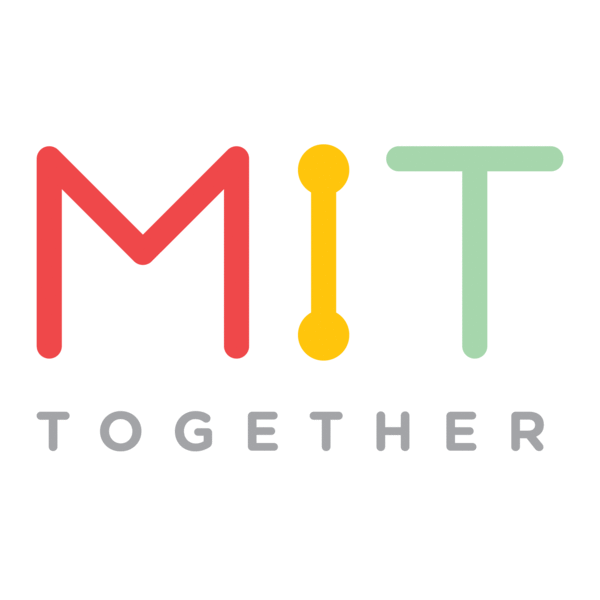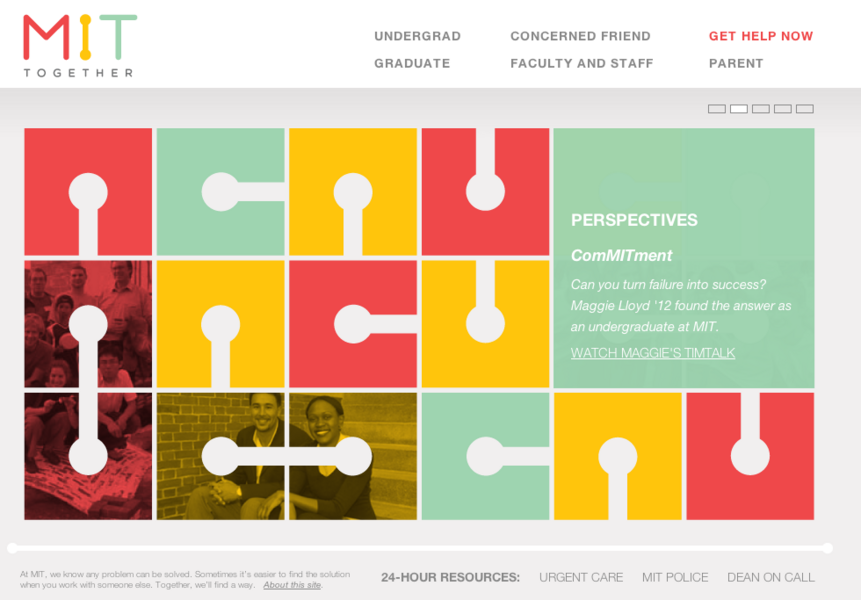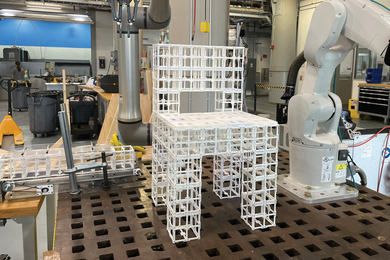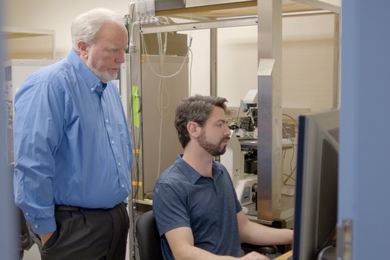A student at MIT who feels isolated or overwhelmed doesn't have to go it alone: most problems are easier to solve if you work with someone else, together.
That's the central message of MIT Together, a new campaign launched by Chancellor Eric Grimson this fall. "We believe that MIT gains strength as a community when all of us work together in ensuring that everyone is well," Grimson says. "MIT Together provides guidance and reassurance for individuals by demystifying and destigmatizing the resources available to students in need."
The focal point of the campaign is a new website, together.mit.edu, that helps graduate and undergraduate students navigate MIT's broad network of support services. The site includes descriptions of specific resources ranging from Mental Health & Counseling to peer-to-peer services, student-created content about overcoming challenges, and dedicated pages on how to help someone in distress for concerned friends, parents, faculty and staff.
"MIT Together fills the need for a yellow pages of support on how to feel better," says Susanna Barry, senior program manager in Community Wellness at MIT Medical. "When people know they could feel better, but they don't really know how to start, MIT Together is the perfect place."
Together is the MIT way
To build awareness of the website, the campaign also includes efforts such as posters, door hangers, ads on the digital displays in the Infinite Corridor and community spaces, and business cards. Much of the messaging tries to appeal to the quirks and personality of MIT — for example, one poster even spells out its message with equations — to capture students' attention.
"The goal is to establish in student minds that if you're ever feeling like you need support, you only have to remember one word: Together," says Tom Gearty, director of communications and special assistant to the Dean for Student Life, who developed the campaign.
Gearty says that the campaign is built around the word 'together' because it represents how the MIT community tackles any challenge: by working together. "MIT encourages collaboration, whether through p-sets for freshmen or multi-disciplinary research," Gearty says. "We want students to know that if they have personal or academic challenges, they can take this same approach. They don't have to go it alone."
MIT Together not only seeks to direct students to resources where they can get aid, but also lets them know what will happen once they reach out for help. "When we began to talk to students about what kind of barriers are impediments in seeking support, what we heard was that sometimes students didn't know what would happen if they reached out to a particular service," Gearty says. "MIT Together not only explains where to find support, but what will happen after a student reaches out. "
'We all need help sometimes'
It is not uncommon, Gearty says, for students to think that getting support is a sign of failure or weakness. MIT Together, therefore, also aims to eliminate any perceived stigma with asking for help.
"Everyone who comes to our office for support thinks that they are the only one with problems," says David Randall, associate dean of Student Support Services (S3), a resource for undergraduate students featured through MIT Together. "They don't realize there are a lot of other students needing help with the same things."
According to Randall, the staff in Student Support Services receives around 5,000 office visits from undergraduates each year. For the Class of 2012 alone, he says, 56 percent of students visited Student Support Services during their time at MIT, and after that initial visit most students returned an average of three times.
"MIT Together is working to break down the stigma that exists around asking for help," Randall says. "Because we all need help sometimes."
Looking ahead
In the future, MIT Together is looking to expand its offerings to provide more student-generated content and first-person accounts from students who have sought support at MIT. It is also looking to create multimedia representations featuring support staff from various offices and programs around campus so that students can understand better what is offered.
"I hope that through MIT Together, students will better understand that all of us go through failures, experience self-doubt, have occasional stresses in our personal lives, and that seeking help and advice from others is a natural way of overcoming these challenges," Grimson says. "I hope that myths about student support are exposed, and that perceived stigma about seeking help can be eased, so that all students whenever they need some help will feel natural in seeking it out."
That's the central message of MIT Together, a new campaign launched by Chancellor Eric Grimson this fall. "We believe that MIT gains strength as a community when all of us work together in ensuring that everyone is well," Grimson says. "MIT Together provides guidance and reassurance for individuals by demystifying and destigmatizing the resources available to students in need."
The focal point of the campaign is a new website, together.mit.edu, that helps graduate and undergraduate students navigate MIT's broad network of support services. The site includes descriptions of specific resources ranging from Mental Health & Counseling to peer-to-peer services, student-created content about overcoming challenges, and dedicated pages on how to help someone in distress for concerned friends, parents, faculty and staff.
"MIT Together fills the need for a yellow pages of support on how to feel better," says Susanna Barry, senior program manager in Community Wellness at MIT Medical. "When people know they could feel better, but they don't really know how to start, MIT Together is the perfect place."
Together is the MIT way
To build awareness of the website, the campaign also includes efforts such as posters, door hangers, ads on the digital displays in the Infinite Corridor and community spaces, and business cards. Much of the messaging tries to appeal to the quirks and personality of MIT — for example, one poster even spells out its message with equations — to capture students' attention.
"The goal is to establish in student minds that if you're ever feeling like you need support, you only have to remember one word: Together," says Tom Gearty, director of communications and special assistant to the Dean for Student Life, who developed the campaign.
Gearty says that the campaign is built around the word 'together' because it represents how the MIT community tackles any challenge: by working together. "MIT encourages collaboration, whether through p-sets for freshmen or multi-disciplinary research," Gearty says. "We want students to know that if they have personal or academic challenges, they can take this same approach. They don't have to go it alone."
MIT Together not only seeks to direct students to resources where they can get aid, but also lets them know what will happen once they reach out for help. "When we began to talk to students about what kind of barriers are impediments in seeking support, what we heard was that sometimes students didn't know what would happen if they reached out to a particular service," Gearty says. "MIT Together not only explains where to find support, but what will happen after a student reaches out. "
'We all need help sometimes'
It is not uncommon, Gearty says, for students to think that getting support is a sign of failure or weakness. MIT Together, therefore, also aims to eliminate any perceived stigma with asking for help.
"Everyone who comes to our office for support thinks that they are the only one with problems," says David Randall, associate dean of Student Support Services (S3), a resource for undergraduate students featured through MIT Together. "They don't realize there are a lot of other students needing help with the same things."
According to Randall, the staff in Student Support Services receives around 5,000 office visits from undergraduates each year. For the Class of 2012 alone, he says, 56 percent of students visited Student Support Services during their time at MIT, and after that initial visit most students returned an average of three times.
"MIT Together is working to break down the stigma that exists around asking for help," Randall says. "Because we all need help sometimes."
Looking ahead
In the future, MIT Together is looking to expand its offerings to provide more student-generated content and first-person accounts from students who have sought support at MIT. It is also looking to create multimedia representations featuring support staff from various offices and programs around campus so that students can understand better what is offered.
"I hope that through MIT Together, students will better understand that all of us go through failures, experience self-doubt, have occasional stresses in our personal lives, and that seeking help and advice from others is a natural way of overcoming these challenges," Grimson says. "I hope that myths about student support are exposed, and that perceived stigma about seeking help can be eased, so that all students whenever they need some help will feel natural in seeking it out."







